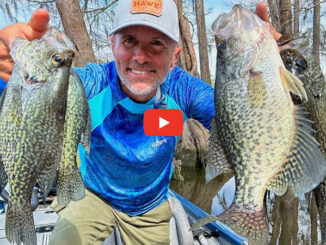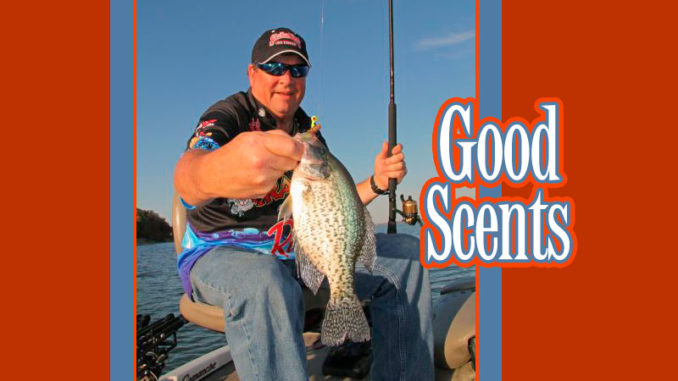
Adding smell to your crappie baits increases appeal and results in more bites. Here are some expert thoughts.
If you hear Jerry Thompson order cheese on the burgers, you better clarify what he means before assuming it’s lunchtime. Word to the wise: Often the Toledo Bend crappie guide isn’t referring to the buns-and-beef — he’s talking about one of his favorite tricks for enhancing his crappie baits.
“Any of the scent attractants will get you 2-3 more bites in a day, but the Berkley Powerbait Crappie Nibbles will increase your bites 10 percent,” Thompson explains. “Just stick it on the hook with your minnow and it works. We call it ‘adding cheese to the burger.’
Thompson surmises that it’s the combination of scent and color that bolsters his minnow’s appeal. Historically, he’s used mostly chartreuse Crappie Nibbles, but this year has seen pink take the lead in productivity.

Indeed, crappie may be sight feeders, but they have nimble noses and while, there are times of the year when it just doesn’t matter how a bait smells, other times find the olfactory stimulus playing a bigger role in this show.
“During the prespawn and spawn are the most awesome times because fish are fired up and they’re in a frenzy,” said crappie tournament pro Doug Cherry. “But during the summer, the fish are lethargic. The thermocline affects the water and crappie suspend below that (warmer water). They’re not feeding much at all.”
Cherry’s fellow Strike King pro Bart Gillon agrees and adds this: “Prespawn is the best bite of the year and I’m not as concerned with using scents because if you’re in the right area, they’re going to bite just about anything. But from postspawn through fall, the fish are worn out, they’re scattered and you just about have to bump them in the nose to get them to bite.
“That’s when adding scent to your baits can really help. You’re struggling to get that fish to bite and anything you can do helps you that much more.”
Thompson concurs: “Anything you do will get you (a few) more bites in a day, so it’s worth trying. I’ve never seen a scenario where they wouldn’t bite something with a scent attractant and they would bite the same bait without it, so it can’t hurt you.”
Now, opinions may vary a bit on the importance of scents during the warmer months, when a lot of crappie anglers are long lining crankbaits and jigs in hopes of stimulating reaction bites. Nevertheless, with more targeted tactics, you’ll do well to make your baits as enticing as possible. Minnows definitely sweeten the presentation, but the concentrated aromas available to the modern crappie anglers broaden the sphere of influence.
Scent in many forms
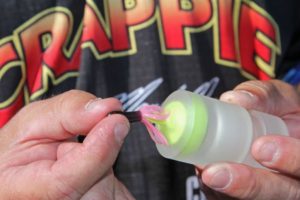
One school of thought says to use soft plastic bodies impregnated with various formulas including amino acids, pheromones and other stuff that smells like baitfish, crawdads, worms and the like, while others keep it simple with straight-up garlic. Brands such as TriggerX, YUM and Berkley offer a diverse array of crappie sized baits with various scent bouquets, and while opinion variance rivals that of color selection, just figure what works for you and go with it.
Old school works too. Strike King looks to the culinary world for the seasoning it uses to inject the plastics in its lineup of Mr. Crappie baits. Wally “Mr. Crappie” Marshall explains.
“The Mr. Crappie by Strike King soft plastics (Jokers, Thunders, Shadpoles, etc.) have Anise oil injected into the baits for a liquorish smell that seems to drive crappie to strike,” Marshall said. “Old-timers used Anise oil for all types of fish and you can still purchase it at your local grocery store in the spice section.”
Soaking stale baits in various fish oils, anise oil or Berkley Gulp Alive Recharge Liquid restores them to their fish-tempting form. In a pinch, even minnow bucket water can help.
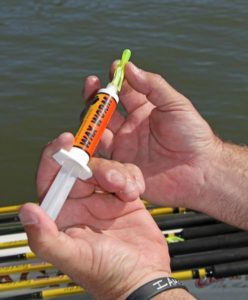
For more intimate treatment, savvy crappie anglers spice up each individual baits with scent attractants in gel, spray and stick form similar to lip balm products. The latter two are typically applied to the bait’s exterior, while gels are often injected into the body cavity of a tube baits.
Expanding on the injection concept, a handy tool called the Bait Pump (thebaitpump.com) deserves a place in any scent-conscious crappie angler’s tackle bag. Picture a short, fat hypodermic needle with a narrow nose instead of a poker. You’ll use this setup similar to those scent products that come prepackaged in applicators, only you’ll form your own scent paste.
Start by unscrewing the cap piece, filing the pump’s chamber up to the cap’s thread lines with scented pellets such as Berkley Powerbait Crappie Nibbles and then replacing the cap. Slowly tightening the cap crushes the soft pellets into one homogenous paste, which squeezes out the nose and into a tube body.
Yet another strategy pulls a little trick from the bass world and combines added scent with the visual attraction of dyes such as JJ’s Magic or Spike It Dip-N-Glo Worm Dye. We’re mainly talking the sniffy stuff here, but a little back-end contrast is a known fish-getter.
Scent sentiments
Ask Cherry what he’s using on his plastics and he’ll quickly show you a tube of Kodiak’s Minnow scent.
“There is nothing better,” Cherry proudly states. “It is hot with a capital H, O, T.”
Cherry’s tournament partner Mark Williams likes that product too, but he’ll always have one of those KVD Fish Sticks handy. Rubbing the solid baits, while injecting the tubes covers the bases, Williams says.
Gillon has his preferences, as well. For him, top billing goes to Kodiak’s Wax Worm gel. Reason? That taste is a novelty for southern fish.
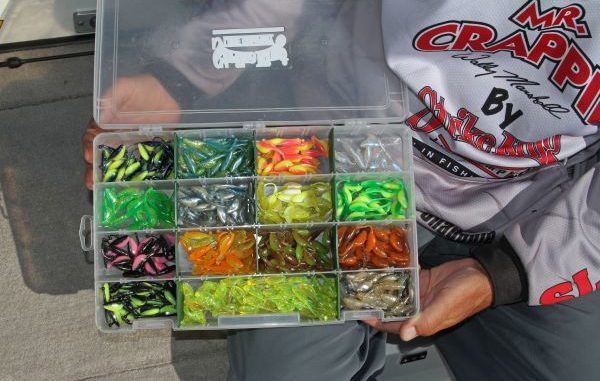
“The wax worm is like that big chocolate cake that you only get one time a year from grandma,” he said of the Wax Worm scent’s come-and-get-it appeal. “I think it’s just something a little out of ordinary that the fish don’t get to taste very often. When they do smell it, they come running.”
Notwithstanding the charm of his favorite scent, Gillon said he’ll often diversify his spread by dosing up half of his baits with the Wax Worm gel and spraying the other half with a garlic aerosol.
“Most of the time, it’s trial and error. I’ll have both in the boat and depending on the lake,” he said. “These four poles will have this scent and these four rods have this scent and you just see which one that works best. It’s just like picking your color of the day. If I get something that’s working consistently I’ll change them all to that.
Scents to serve
When selecting your scent products, consider the two main strategies: First, gels and pastes adhere to the bait to increase its attraction at the point of the bite. Making the bait taste more appealing might make the fish hold on a little longer so you don’t miss as many lighter bites.
For his plastics, Thompson said he’s more likely to go with a gel formula attractant if for no other reason than the elimination of redundancy. “It needs to be something that will stay with the bait. I like the jellies because they stick to the baits and you don’t have to put it on that often.”
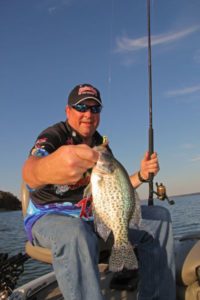 Conversely, liquid sprays and aerosols are made to gradually disperse from the bait, spread throughout the water and attract fish from afar. In either case, Gillon said that anglers will maximize the benefit of scent by moderating their presentation speed.
Conversely, liquid sprays and aerosols are made to gradually disperse from the bait, spread throughout the water and attract fish from afar. In either case, Gillon said that anglers will maximize the benefit of scent by moderating their presentation speed.
“I think the slower you go, the better,” he said. “I think you present a scented bait slower than a non-scented bait because if you just whiz it by the fish, your bait may be gone before they even know it’s there.”
Gillon said the best tactics for maximizing scented and scent-added crappie baits are one-pole jigging and tight-lining trolling at approximately 3/10 mph. As Alabama crappie chaser T.J. Stallings points out, the year-round effectiveness of scents really starts to shine during the tough summer months. Notably, scent dispersion is strongest in warm water, so the whole picture kinda works together.
That’s particularly important when wind, rains or excessive boat traffic has the lake stirred up. Crappie are primarily sight feeders, but when visibility declines, scent enhancements let them know there’s food to be had.
Thompson said there’s not really a wrong time to add scents to crappie baits, as he’s seen them yield positive impacts spring-winter. He does, however, note that water clarity factors into the equation. And not that scents would hurt you in clear water; they’re just more of a necessity in the stained to dirty waters like the Red River and the Atchafalaya Basin.
Moreover, Thompson said that, as increased fishing pressure continues to educate the fish, he expects to see trolling tactics become even more prevalent in coming years — especially on his Toledo Bend home waters. He urges trollers to consider the benefits of dosing up their baits with something smelly.
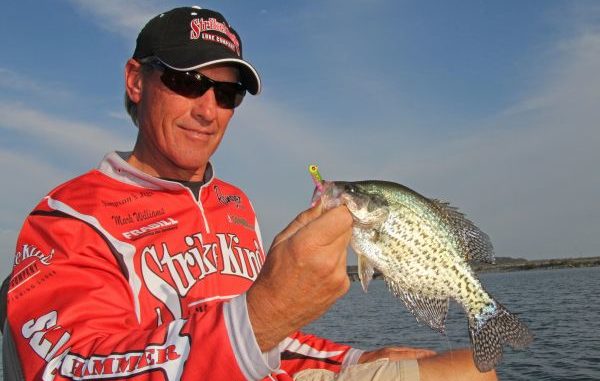
“Covering more water by trolling will spread that scent farther,” he said. “If you’re using scent when you’re trolling it will get those fish fired up when you pass through. And then you come back through the area, you’ll help yourself out.”
Crappie scents in suspense
Even for the tournament types, crappie fishing doesn’t always need to be a high-strung tension fest. No doubt, you’d be amazed at the therapeutic benefits of dropping the anchor and deploying a few float rigs baited with something smelly.
For sure, live minnows will always keep you in the game, but as the weather continues warming and crappie continue to turn cantankerous through summer, giving them something to sniff is often the deal closer. Productive bait options packaged in convenient nugget form include:
- Stubby Steve’s (stubbysteve.com)
- Magic Bait Crappie Bites (Magicbait.com)
- Berkley Powerbait Crappie Nibbles (basspro.com)
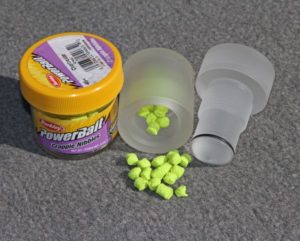 Crappie aficionado T.J. Stallings knows a thing or two about floating baits for the freckle fish. He offers these tips for optimal performance:
Crappie aficionado T.J. Stallings knows a thing or two about floating baits for the freckle fish. He offers these tips for optimal performance:
Better Buoyancy: Bobbers or floats? Bobbers are like beach balls that pinch the line. A small foam float is more aerodynamic and does less harm to the line. Better anglers know that smaller floats are easier for fish to pull down and get hooked. Large floats are great for feeding fish.
Hook Size: Match the hook to the bait and the fishes’ mouth. An Aberdeen, fine wire hook in size 2 is perfect for most crappie. However, if they are running over 10 inches, move up to size 1. For massive crappie, like those in Grenada Lake where the minimum size is 12 inches, a larger 1/0 size is better.
Hook Style: Cam-action hooks like Mr. Crappie and the Tru-Turn brands, land more fish because they rotate toward pressure and result in more hook-ups.Loads of fun for kids and equally enjoyable for adults, a float setup allows you to present you baits over brush piles, in front of deep dock faces, standing timber and anywhere those crappie may be holding. Simplifying the operation and eliminating the need to carry or tow a minnow bucket, synthetic crappie baits offer a no-frills approach with often delightfully productive results.
Scented crappie baits – the facts
Crappie anglers have many products from which to choose. Some may be marketed more heavily to the bass world, but a shad is a shad and garlic is garlic, regardless of who’s smelling it.
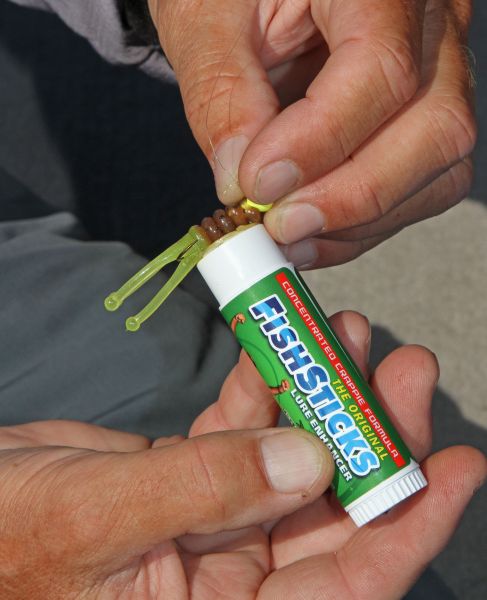 The leading crappie scent products include:
The leading crappie scent products include:
- Bang Fish Attractant (tacklewarehouse.com)
- Berkley Gulp! Alive Attractant Spray (Cabelas.com)
- Bio Edge (www.bioedgefishing.com)
- Bobby Garland’s Mo’Glo Slab Jam (bobbygarlandcrappie.com)
- Dr. Juice Super Tournament Juice (www.rapala.com/blue-fox/accessories)
- Fish Sticks KVD Lure Enhancer (tacklewarehouse.com)
- Kick’N Crappie Oil (KickNbass.com)
- Kodiak Paste (crappieusa.com)
- Mega Strike Fish Attractant (tacklewarehouse.com)
- Pro Cure Gel (pro-cure.com)
- Smelly Jelly (Cabelas.com)
- YUM F2 Attractant (lurenet.com)

